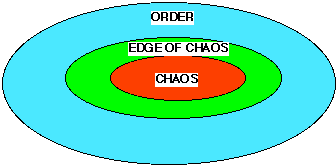
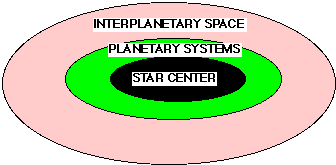
Abstract:
Using systematic analysis of phenomena across levels of complexity of existence enables a clearer understanding of the underlying structure and evolutionary process of the universe. The concept of major levels of complexity provides a framework for explaining the interaction between two adjoining levels of complexity. This interaction is a form of information feedback. This feedback is analogous to biological evolution but appears in simpler levels of complexity that do not involve life. In addition, at higher levels of complexity, the feedback is at multiple levels thus adding to the confusion of the evolutionary mechanisms of life. Extending the recent developments in the "science of complexity," the analogous concepts of birth, growth, and death are shown to be fundamental processes that necessary at all levels of increasing complexity. The word involution is used to represent the process and structure of existence which creates this increasing complexity.
Involution:
The Structure and Process of Existence, Revisited
Towards The
Physics of Death
Phenomenology
of Massive Dissipative Structures
The first problem in explaining the diversity is to categorize it, so as to be able to distinguish or differentiate the "things" in the universe so as to be able to use these distinctions in the discourse of reason. This has been the task of science since the Greek philosophers of antiquity started trying to objectively analyze the world. However, the major problem in science has been dealing with the "complexity" of nature[1].
There are many different complex phenomena in each field of science. Until now it has been difficult to compare phenomena between fields of science, such as physics, chemistry, biology, anthropology, and economics, in a systematic manner because it has appeared that the properties and processes of these phenomena are radically different. On the other hand, there seems to be some vague similarity between radically different phenomena of universe, such the evolution of stars and planets to the evolution of life. Indeed, the science of complexity [2][3][4] is beginning to shed some light on this similarity, and it appears there is some important commonalty between the sciences. A building of this commonalty in terms of a scientific theory could profoundly change our understanding of all the sciences and ultimately our understanding of the universe. Yet, communication between different sciences in regards to this fundamental commonalty at best at its beginnings. Scientists from different fields have difficulty in communication because they view their scientific fields as very different and effectively they speak different "languages". Nevertheless in terms of this new scientific world view, a building of a commonalty now seems possible because each field of science has a great deal of knowledge accumulated and can serve as a solid basis that can be used to analyze analogous phenomena.
In understanding the structure and process of the universe there are three important descriptive parts to the analysis in terms of the science of complexity. First part of the descriptive analysis is the naming and defining of each level of complexity of existence. This is an ambitious task, but in the process of trying to delineate and define each level, a better understanding of the fundamental commonalties between all levels will occur. In defining the levels, we must first characterize what it a level of complexity means and how one can recognize it. In this paper, the notion of major levels of complexity is introduced and used to provide an initial framework for understanding the information feedback between the major levels in time as the universe evolves. Table 1 illustrates what are the major complexity levels that should serve as the currently understood levels. In addition, there are successive minor levels of complexity that are between the major levels but are harder to define and discover because the evolutionary process destroys a great deal of the evidence.
The second part of this descriptive analysis is the process description of each level of complexity. In this process description, it is important to show the commonalty between levels. This common process description, hereby called involution, will represent the common theory on how levels of complexity arise and what is the underlying structure and process of the universe. For starters there seems to be three basic views on this process. The analogous notions of birth, growth, and death appear to common to all levels of complexity from galaxies and stars to human society and cyberspace. For example, it appears that catalysts in chemistry has a similar role of birth as genomes have in biology, and as memes have in sociology. Mapping seemly different processes into precise analogies between these processes at different levels of complexity will clarify the underlying common process. This mapping involves making explicit the information feedback between levels. The mapping is again an ambitious task, and requires the deep understanding of the each level of complexity. On the other hand, there is a great deal of knowledge accumulated at each level of complexity by the respective sciences and vast amount of work has been performed in the sciences that straddle the levels of complexity, such as molecular physics, biochemistry, and ethnology.
Hand-in-hand with the process description is the structural description.
One approach to devise a structural description, and the approach taken
here, is to first catalog the major organizational entities of each level
and the current major species, and if possible provide the history of evolution
of species at each level. Analogous to the drive to catalog "life" by Linnaeus,
this catalog can serve as lingua franca to generalize and unify the disparate
phenomena that occur in the different fields of science. Table 1 serves
a sample of the top level listing of the major levels of complexity with
example major species in that level complexity. Just as there is no perfect
classification scheme in biology, there will not be a perfect classification
in the science of complexity. On the other hand, just as wrong classifications
served as a counterpoint foundation for discovery of better explanations
as in the work of Lamarck, Cuvier, and Darwin in biology, so can this catalog
and others serve as a framework of scientific inquiry for the science of
complexity.
| Complexity
Level |
Species
Complexity |
Major Species | MacroSystem Lineage |
| 0 | Quanta (quarks leptons) | Neutrinos | Universe |
| 1 | Particles (Baryons Mesons) | Proton | Galaxy System(Milky Way) |
| 2 | Atom | Iron | Star System(Super Giant) |
| 3 | Molecule | Water | Planetary System(Earth) |
| 4 | Cell | Cyanobacteria (prokaryotes) | Biological System(Earth) - Gaia |
| 5 | Organism | Proctistia (eukaryotes) | Organism System(Earth) - Hypersea |
| 6 | Family | Ant Colonies | Family System(Earth) |
| 7 | Society | Corporations | Societal System(Earth) |
| 8 | CyberSocieties | MetaMan (internet mankind industry) | CyberSocietal System(Earth) |
Part of the problem with using the concept of complexity is the problem of defining exactly what consists of "the system" or the entity which encompasses the complexity. We will argue that some delineation's of systems are more natural than others for understanding how the complex things arise, such as living organisms. We will use the word complexity with a different meaning than the above usage's. We will use a particular meaning the word that include both process and structural aspects of the world. In other words, we are considering long-term, dynamic complexity.
If we look at nature and notice the entities that have been discover as building blocks in this complex world, we quickly find the results of science have given several levels of entity description. Through scientific consensus the words quanta, particle, atom, molecule, cell, organism, family, and society represent classes of entities that appear identifiable in some of the scientific disciplines. These words as concepts are useful in terms of a very naive definition of the word complex. If we take the simple usage of something is complex if "it is made of parts", then we find that a society is composed of families, a family is composed of organisms, an organism are composed of cells, cells are composed of molecules, molecules are composed of atoms, atoms are composed of particles, and particles are composed of quanta(bosons, leptons, quarks). This usage will serve as the basis of our notion of complexity.
This notion at first glance seems correct in the intuitive aspect of
common usage of word "complexity" and gives a nice ranking of complexity
that seems natural. That is, for example, societies are more complex than
molecules because societies at some level are composed of molecules. Richard
Dawkins in The Blind Watchmaker [8] uses this notion
of complexity to discuss the evolution of life. But, this simple usage
of the word complex does not have a precise definition of "parts," and
there is the problem of defining the extent of the whole. This naive notion
of complexity, although intuitively correct, must also address what is
relationship of the parts to the whole. And just as important, there remains
the question of what is the definition of the whole. Part of understanding
this part/whole relationship comes from examining the underlying process
of increasing complexity. This underlying process is hypothesized in the
following section.
We aim to illustrate that this characterization of these three regimes appears to be the underlying process structure of the increasing complexity of existence. Abstractly, each level of complexity has three basic regions as depicted in Figure 2a: the chaotic region, the order region, and the edge between the chaotic and order region. Figure 2b depicts the major level of complexity 2 in terms of these three regions. The chaotic region of a level of complexity supplies the evolutionary energy for the growth of an "edge of chaos" for the next level of complexity. The order region is the "material" area for storage of dynamic structures that were created by the process at the edge of chaos. The order region largely preserves the information at a level of complexity in these dynamic structures. But in addition, these structures in the order region can be fedback into the edge of chaos by energy fluctuations created by the turbulence of the chaotic region into the dynamic structures of the order region.


A Level of Complexity Major Complexity Level 2
Figure 2a Figure 2bIn this paper, the discussion of levels of complexity will primarily center on major levels of complexity. There are multiple levels of complexity between major levels of complexity, but characterization of these levels is difficult to define because the evolutionary nature of the edge of chaos process.
The above characterization of a major level complexity depends on defining what are the individual micro-components and an overall macro-organization within a larger context. In this type of characterization there are two types of systems: "microsystems" and "macrosystems."
Microsystems are the dynamic structures that are combined to form more complex structures within macrosystems. Microsystems are the natural occurring building blocks that compose things: quanta, particles, atoms, molecules, cells, organisms, families, and societies. Microsystems are composed of several levels of underlying microsystems. A microsystem at major level N must have some forms of microsystems that are level N-1.
On the other hand, macrosystems form the context for microsystems. The universe, galaxies, star systems, planetary systems, and the earth's biosphere are examples of macrosystems. Macrosystems are formed from the underlying process of chaos and order from within a larger context that has direct lineage to the involution of the universe. All microsystems and macrosystems are contained within at least one macrosystem context, that is, the universe.
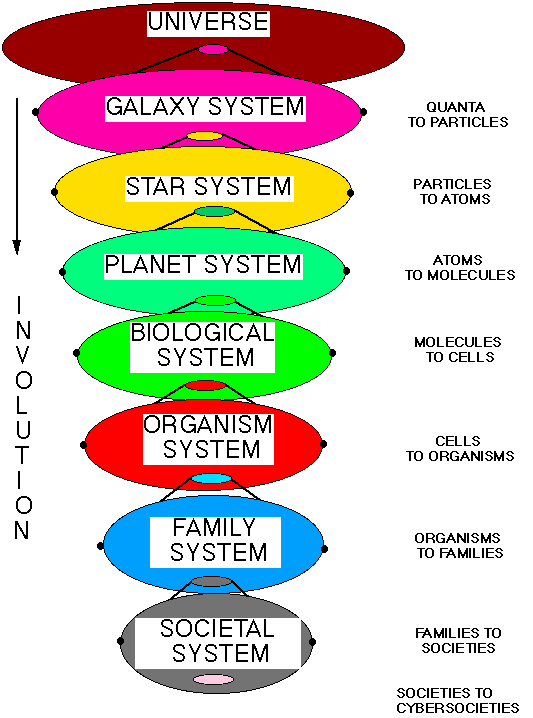
Figure 3. Involution of Our Existence: The Current Major levels of Complexity
Figure 3 represents the current involution path of our existence, with the successive higher level macrosystems being a smaller and smaller part of the larger context.
Another view of a level of complexity is the characterization of the phases of dynamic organization of microsystems. Figure 4a represents a phase space of a level of complexity. Figure 4b represents the major level of complexity 2. The morphogenesis of simpler entities into a dynamic structure represent the phase change from chaos to order. For the complexity level 2, the morphogenesis is from particles to atomic nuclei. The growth from nuclear ion to atom by capturing electrons represents the phase change from the edge of chaos to order.
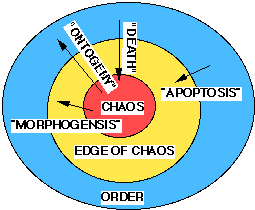
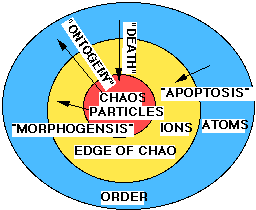
Figure 4(a) Figure 4(b)
A major level of complexity phase space Major Complexity Level 2 Phase SpaceTo more concretely describe the process, we will use the example of the solar system as a major level of complexity 2. From a scientific point of view, this level of complexity is the probably the most understood level. On the other hand, ultimately, to fully understand a level of complexity, all the lower levels must be described also. However, to simplify the explanation of the process, the formation of hadrons and fermions in the complexity levels below level 2 will not be described.
In the solar system (complexity 2), the chaotic regime's center is at the center of the sun. The center of the sun is the most chaotic because of its temperature (15,000,000 degrees) and is reflected by the energy of elementary particles in the center. The entire sun is chaotic relative to anything more complex than nuclei of atoms, i.e., ions. The center of the sun is chaotic relative to individual atoms. In this chaotic region, no stable structure that consists of anything more complex can exist. That is, any matter of higher complexity that is drawn into the sun is subject to the destruction in terms of molecular structure and anything more, such as crystalline or cellular structure.
The order region (complexity 2) of the solar system encompasses the interstellar space affected1 by gravitation of the mass of the sun. This order regime surrounds the chaotic region centered in the sun. The order region (complexity 2) contains atoms wherever particular regions of mass that are not part of the sun and small enough and far enough away from the center of the sun to cool below nuclear reaction temperatures.
Any matter that is not frozen in the order region is between the order and chaos regimes. Thus, the geological active planets are on the edge of chaos of the solar system. Nevertheless, some frozen material in the order region such as comets and asteroids can be eventually pulled back into the edge of chaos by virtue of their long-term trajectories and interaction with the established planets. In fact, the planets were formed by an aggregation process, where the largest planetesimals formed by gravitational and electromagnet waves of entire stellar mass served as centers on the edge of chaos (complexity 2) of the solar system.
The next major level of complexity
The edge of chaos at one major level of complexity contains the chaotic region for the next higher level of complexity. A molten center of a planet is on the edge of chaos of solar system (complexity 2) which serves as the atomic chaotic center (complexity 3) to form molecular compounds. Figure 5 represents the phase space of major level of complexity 3.

Figure 5. Major Complexity Level 3 Phase Space
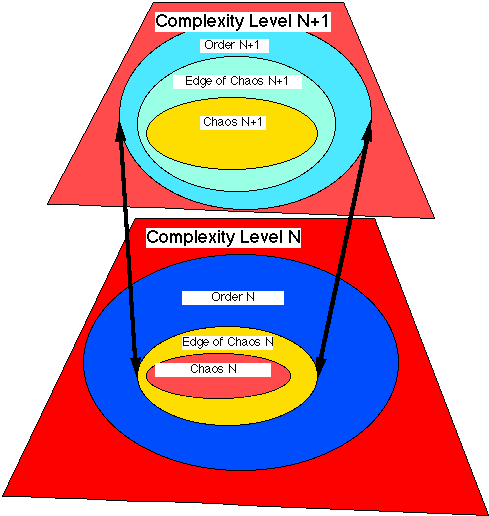
Figure 6. Two levels of Major Complexity.
Figure 6 illustrates the arising of the next level of complexity from the level below. The edge of chaos region N-1 contains the chaotic region N. The illustration is conceptual, because the next higher level of complexity is physically contained in the lower level of complexity. Moreover, the region between order and chaos, "the edge of chaos," is a not physically continuous region, and the edge of chaos is very small compared to the order and chaotic regions. ("The edge of chaos" is probably approximately 10-7 smaller in mass-energy than the chaos region, and approximately 10-7 smaller in space-time than the order-region.)
Returning to our example, in the initial formation of the sun, the matter not part of the hot, gaseous sun is on an edge of chaos(complexity 2). As the mass in the vicinity of formation of the sun collapses into a stable star, the matter farthest from the chaotic center crystallizes into frozen planets and asteroids. The frozen matter becomes part of the order region. Any atomic nuclei in the order region attract electrons to form atoms and then combine at the molecular-level (complexity 3) based on the geology of the physical mass in the area. Faster the cooling to solidification and crystallization, the fewer species of molecular chemicals have chance to form.
Figure 4b represents a type of phase space of the matter at the level of major complexity 2. Individual entities go through a morphogenesis process. At the solar system of complexity, complexity level 2, the aggregation process is a morphogenesis process that combines protons to create helium nuclei. Besides being the center of the creation of light nuclei, the sun has collected nuclei that were created from previous generation stars. These nuclei came from the order region of the galaxy (complexity 1). The heavy atoms of previous generations were stripped of any molecular structure by the high energy in the chaotic region of the sun. Sometime during and after the sun formation, the many of planets were formed consisting almost exclusively from these previous generated nuclei. As the planets formed, the many of nuclei in the planets and asteroids quickly matured and stabilized to atoms by acquiring the electrons because temperatures were below plasma temperatures.
All the planets that continue to cool but have not become geologically dead are still on a edge of chaos (complexity 2). In the formation of planets, the large planetesimals that served as the collection point of the planet define this edge of chaos (complexity 2). Once a planet has cooled sufficiently, there is the possibility of ions acquiring enough electrons to form atoms or combining with other ions to form molecular compounds. In the beginning the combinations would be simple. However, as the planet continued to be chaotic in movement of atoms(complexity 3), the forming and destroying of compounds would continue to take place.
In the gas giants, gravitation can retain the dominant atomic species of hydrogen and helium, thus the dominant molecular species would be hydrogen and helium molecules. In the smallest planets or moons, the geologic processes will continue for some time after formation, but lose most of the light gases into interplanetary space. These smaller bodies are left with the heavier elements dominating the geologic processes.
The next level of major complexity above the star system (complexity 2) is the planetary system (complexity 3). With geologic processes continuing on the planets, the creation of more complex molecules would proceed. Each planet is a center of atomic chaos (complexity 3), that is because of the heat from radioactivity and pressure, no molecular bonds can be maintained. The planet surface and the interplanetary space is the order region (complexity 3). The chaos, edge of chaos, order regions of complexity 3 are contained in the edge of chaos (complexity 2). Typically, a edge of chaos of complexity 3 is the planet's surface. In the case the gas giants, their geologically active moons are also on an edge of chaos (complexity 2). If there is no interaction between the spatially separately atomic chaotic centers, then there are separate region of edge of chaos (complexity 2) for each atomic chaotic center (complexity 3).
The earth provides a stable source of atomic chaos because of its size,
having singular moon, and its distance to the sun. The earth appears to
be the closest planet to the middle of the edge of chaos of the solar system.
The earth's surface is the center for the moderately complex elements of
carbon, oxygen, etc. The earth is the only example that humans can observe
at present that sustains higher, major levels of complexity than three.
There remains a great deal of work to detail all the major levels of complexity and start classifying levels of complexity between the major levels. There is a great need to begin the field of comparative complexity, which can help in understanding our world better.
An entity X is complex if it has "observable" parts P(i) that can "observed" as entities outside the entity X. To "observe" P(i) outside of X, P(i) must be able to "operate" and maintain its internal organization in the manner it did inside of X until the "observation."
Word Usage: Major Complexity
The property of being complex. An entity X has major complexity of one more than the maximum of the major complexity of its parts. A entity X is more complex than another entity Y if all the parts in Y exist in X and there exists a part P(i) in X that cannot exist in Y as a part of Y without destroying fundamental organization of the entity Y and the part P(i).
Word Usage: Fundamental organization
A structure with parts: where relationship of the parts are defined in terms of a ongoing process that requires all of the essential parts of an entity. Without the process continuing, the all parts in the structure will no longer maintain their same physical interaction with the other parts.
Example 1: A molecule is more complex than an atom. E.g., a there exists a part P(i) (the oxygen atom) in a molecule X (carbon dioxide) that cannot exist in the atom Y (silicon). In other words, one cannot take the oxygen from a molecule of carbon dioxide and put it in the atom silicon and keep an atom oxygen without destroying the identity of the silicon atom and the oxygen atom. Atomic fusion of silicon and oxygen destroys the fundamental organization of the entity, the silicon atom, and the oxygen part of the molecule carbon dioxide. Combination of the atom silicon and the oxygen part of the molecule carbon dioxide can occur to form silicon oxide; however, this is a molecule and the oxygen part is not a part of the atom silicon.
Example 2: A organism is more complex than an cell.. E.g., a there exists a part P(i), the human cell, in a human organism X that cannot exist in the cell Y (bacteria). In other words, one cannot take a cell from a human organism and put it in the cell bacteria and keep the human cell without destroying the identities of the bacteria cell and the human cell. Cell fusion of between bacteria and human cell destroys the fundamental organization of the entities: the bacteria cell and the cell of part the human organism. Combination of the bacteria and the human cell of the can occur, such as E. coli in the human gut. Nevertheless, this combination is a part of a organism and the human cell part is not a part of the cell bacteria.
[2] Prigogine, I. and I. Stengers, Order out of Chaos, Bantam Books, 1984.
[3] Kauffman, S. The Origins of Order, Oxford University Press, 1993.
[4] Gell-Mann, M., The Quark and the Jaguar, WH Freeman, 1994.
[5] Wolpert, D., The relationship between Occam's Razor and Convergent Guessing, Complex Systems, pp 319-368, Vol 4, 1990.
[6] Bennett, C.H., In Emerging Syntheses in Science, D. Pines, Ed. 1988.
[7] Lloyd, S. and H. Pagels, "Complexity as thermodynamic depth, " Annals of Physics, pp 186-213, 1988.
[8] Dawkins, R., The Blind Watchmaker, Norton & Company, 1987.
[9] Langton, C., Computation at the Edge of Chaos, Phase Transitions and Emergent Computation, Physica D, pp12-37, Vol 4, 1990.
[10] Mitchell, M., J. Crutchfield, and D. Hraber, "Dynamics, Computation, and the Edge of Chaos: A Re-Examination, G. Cowan, D. Pines, and D. Melzner (editors), Integrative Themes, Santa Fe Institute Studies in the Sciences of Complexity, Proceedings Volume 19. Reading, MA
Involution:
The Structure and Process of Existence, Revisited
Towards The
Physics of Death
Phenomenology
of Massive Dissipative Structures